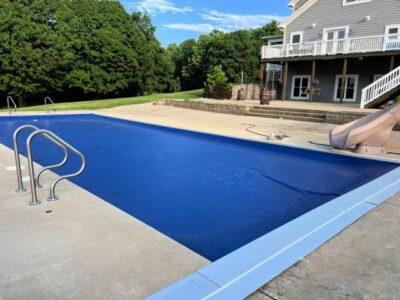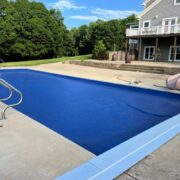A level, sturdy floor is the unsung hero of any space, whether it’s a vibrant retail shop, a serene home, or a heavy-duty factory. Uneven surfaces can spell trouble—cracked tiles, wobbly furniture, or compromised machinery. That’s where Floor Screed comes to the rescue, offering a cost-effective, reliable solution to create a smooth, durable base for any flooring project. In this detailed guide, we’ll uncover the transformative benefits of floor screeds, their diverse applications, and why Polycote’s cutting-edge products, honed over 25 years, are the gold standard for professionals and homeowners. Whether you’re revamping a boutique or laying the groundwork for a warehouse, Polycote’s screeds ensure your floors stand the test of time.
What Are Floor Screed and Self Levelling Screed?
Floor screed is a cement-based blend spread over a concrete subfloor to deliver a flat, even surface, acting as a foundation for final coverings like hardwood, laminate, or tiles. Its advanced variant, designed for precision, flows effortlessly to self-level, filling imperfections with minimal manual effort for a flawless finish. These screeds are critical for ensuring both structural stability and visual appeal across a range of settings.
For a selection of top-quality, user-friendly options, check out Polycote’s Self Levelling Screed.
Why Floor Screed Is a Game-Changer
Floor screed and its self levelling counterpart bring unmatched advantages to flooring projects, blending functionality with efficiency. Here’s why they’re essential:
Effortless Levelling for Perfect Floors
Uneven floors can derail a project, causing tripping risks or uneven wear on coverings. Polycote’s Easi-Screed Standard flows smoothly to correct surface flaws, creating a polished, dust-free base. This ensures a safe, professional finish for any floor type, from ceramic tiles to polished concrete. For expansive projects, Easi-Screed Industrial can cover up to 2000m² in a single day, delivering a seamless, precision-level surface for retail spaces or manufacturing hubs.
To create a rock-solid foundation, explore Polycote’s Floor Screed range.
Uncompromising Strength for Tough Conditions
Floor screeds are built to endure. Polycote’s Easi-Screed Industrial, with a 40N/mm² compressive strength, is designed for high-traffic environments like distribution centers or automotive workshops, handling heavy loads and constant movement. Its rapid-curing formula supports vehicular traffic in just 24 hours, keeping projects on track. For homes or small businesses, Easi-Screed Flexible offers a resilient 34N/mm², ideal for areas with moderate activity.
Tailored for Underfloor Heating
Underfloor heating systems need a screed that can adapt to temperature shifts without fracturing. Polycote’s Easi-Screed Flexible, with its fibre-reinforced, protein-free composition, is engineered for this challenge. Applicable from 2mm to 50mm thick, it provides a flexible yet robust layer, perfect for cozy homes or modern office spaces with radiant heating.
Budget-Friendly and Time-Efficient
Replacing a damaged concrete slab is a costly, time-intensive process. Floor screed offers a practical alternative, leveling uneven or worn surfaces without major upheaval. Polycote’s screeds are designed for straightforward application, accessible to DIYers and contractors alike. With curing times as low as 2-3 hours for foot traffic, they’re a boon for projects with tight deadlines, slashing both expenses and delays.
Adaptable for Any Environment
Polycote’s screeds shine in both indoor and outdoor settings. Easi-Screed External is formulated to withstand extreme weather, from torrential rain to blistering heat, making it ideal for external spaces like restaurant patios or community plazas. Its ability to resist thermal expansion ensures a durable, crack-resistant finish in any climate.
Polycote’s Diverse Screed Solutions
Polycote’s screed lineup is crafted to address the unique needs of every project. Here’s a closer look at their top offerings:
Easi-Screed Industrial
Engineered for demanding industrial settings, Easi-Screed Industrial is a cementitious screed applied at a minimum 6mm thickness. It smooths rough concrete in factories, breweries, or storage facilities, offering a 40N/mm² strength and a 24-hour cure for heavy traffic, ensuring quick project turnaround.
Easi-Screed Flexible
Perfect for floors with vibration, movement, or underfloor heating, this fibre-reinforced screed can be laid from 2mm to 50mm thick, curing to 34N/mm². It’s easy to apply, supports light foot traffic in 2-3 hours, and suits homes or light industrial spaces. For added durability, seal it with an epoxy coating like Flortex SG.
Easi-Screed Standard
Designed for commercial, light industrial, or heavy domestic applications, Easi-Screed Standard is applied from 2mm to 20mm thick. It cures in 3-4 hours for foot traffic and 12-24 hours for coverings, with non-toxic properties that make it safe for schools, clinics, or residences.
Easi-Screed External
Built for outdoor resilience, Easi-Screed External resists weathering, covering 1.85m² per 20kg unit at 6mm thickness. It’s ideal for external concrete surfaces like loading docks or garden paths, providing a slip-resistant, enduring finish.
Polyurethane and Epoxy Screeds
For specialized environments like laboratories or catering kitchens, Polycote offers polyurethane screeds (6-9mm) and epoxy screeds like Flortex Freeflow (2-3mm). These deliver seamless, hygienic surfaces with chemical resistance, perfect for rigorous conditions.
Applying Floor Screed: A Step-by-Step Guide
Achieving a professional screed finish demands careful preparation and execution. Follow these steps for optimal results:
Step 1: Surface Preparation
Start with a clean, stable base. Clear away dust, oil, or loose debris, and use shot-blasting or scarifying to remove laitance. The surface must be fully cured, solid, and comply with BS8203 1987 dryness standards (relative humidity <75%). For underfloor heating, deactivate it 48 hours before application. Use the right primer, such as Easi-Screed Primer for concrete or WD Primer for non-porous surfaces.
Step 2: Mixing the Screed
Add the specified water amount (e.g., 4.5L for Easi-Screed Industrial, 5.5-6.25L for Easi-Screed Flexible) to a bucket. Gradually introduce the screed powder, mixing with a slow-speed drill and paddle for one minute until smooth and free of lumps. Let it rest for 2 minutes, then stir again. Avoid excess water to maintain structural integrity.
Step 3: Application Process
Begin at the furthest corner, pouring the screed to the desired thickness. Spread it evenly with depth-adjustable floats or a pinned leveller, then use a spiked roller immediately to eliminate air bubbles. Lay each batch within 20 minutes of the previous one to ensure a cohesive finish. For pump applications, confirm a 135mm ± 10mm flow diameter.
Step 4: Curing and Upkeep
Allow curing per product guidelines (e.g., 2-3 hours for Easi-Screed Flexible foot traffic). Protect from water or heavy traffic during curing. For underfloor heating, wait 48 hours before gradually increasing the temperature by 5°C daily. Regular sweeping and inspections keep the screed in top shape.
Selecting the Right Floor Screed
Choosing the ideal screed hinges on your project’s requirements. Consider these factors:
- Environment: Select Easi-Screed Industrial for indoor heavy-duty floors or Easi-Screed External for outdoor surfaces.
- Thickness: Use Easi-Screed Flexible for 2-50mm layers or Easi-Screed Standard for 2-20mm applications.
- Traffic: Opt for Easi-Screed Industrial for heavy loads or Easi-Screed Standard for lighter traffic.
- Special Conditions: Choose Easi-Screed Flexible for underfloor heating or polyurethane screeds for chemical resistance.
- Budget: Polycote’s screeds are economical and easy to apply, fitting various financial plans.
Common Mistakes to Avoid
To ensure a flawless screed application, sidestep these pitfalls:
- Inadequate Prep: Poor cleaning or priming can cause adhesion failures or screed detachment.
- Overwatering: Too much water weakens the screed and risks cracking.
- Delayed Rolling: Not using a spiked roller quickly can trap air bubbles or leave imperfections.
- Neglecting Joints: Ignoring expansion joints can lead to fractures. Use Polycote Jointex for flexibility.
- Applying in Damp Conditions: Single-part screeds require dry surfaces and proper priming to succeed.
Why Polycote’s Screeds Are Unmatched
Polycote’s screeds are celebrated worldwide for their innovation and reliability, backed by over two decades of expertise. From Easi-Screed Industrial to Easi-Screed External, their products prioritize speed, strength, and simplicity. Polycote also provides professional tools like spiked rollers and squeegees, ensuring a perfect application. Their expert support team is on hand to guide you, making every project a success.
The Enduring Benefits of Floor Screed
Opting for high-quality screeding solutions ensures a level, durable foundation that enhances your floors’ longevity and appeal. Polycote’s versatile range caters to residential, commercial, and industrial needs, delivering tailored performance for every scenario. Whether you’re preparing a gym for vinyl flooring or a factory for heavy equipment, these screeds guarantee lasting results.
Ready to build a strong, flawless floor? Discover Polycote’s screed solutions today and find the perfect product for your project. With meticulous preparation and application, your floors will radiate strength and beauty for years to come.












Comments